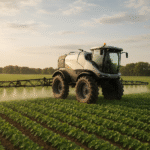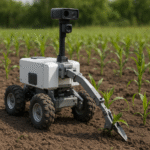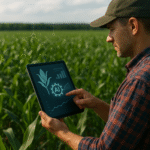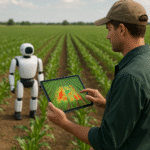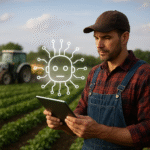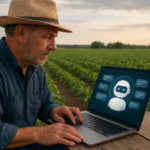Across vast farmlands and bustling supply depots, the integration of AI and Blockchain technologies is ushering in an era of unprecedented innovation. From precision irrigation systems to immutable ledgers tracking every seed, these two powerhouses are redefining what it means to cultivate and distribute food responsibly. This exploration delves into three core areas where this dynamic duo is making a tangible impact on modern agriculture.
AI-Powered Field Management
Agricultural efficiency begins at the very heart of cultivation: the field itself. Through advanced machine learning algorithms and sensor networks, AI transforms routine farm operations into a data-driven science. Farmers can now optimize planting schedules, detect early signs of disease, and allocate resources with unparalleled precision.
Smart Sensors and Predictive Analytics
Equipped with soil moisture probes, weather stations, and aerial drones, AI systems capture a wealth of real-time data. Predictive models then analyze these inputs to forecast crop performance. For instance, algorithms can:
- Recommend the ideal planting date based on historical weather patterns and soil conditions.
- Detect pest infestations by analyzing aerial imagery down to the leaf level.
- Prescribe variable-rate fertilization to enhance nutrient uptake while minimizing runoff.
By leveraging such insights, agricultural operations achieve higher yield optimization and reduce waste.
Autonomous Machinery and Robotics
Automation in the field is no longer science fiction. Tractors guided by AI systems navigate rows with centimeter-level accuracy. Robotic harvesters pick fruit at peak ripeness, and unmanned vehicles deliver precise doses of water and nutrients. This not only boosts productivity but also addresses labor shortages by automating repetitive tasks. Integrating AI ensures that each machine operates with a deep understanding of microclimates, soil variations, and plant health metrics.
Blockchain for Supply Chain Transparency
From farm to fork, the journey of food is complex and often opaque. Blockchain technology emerges as a solution to bring transparency, traceability, and trust to every stage of the supply chain. By recording each transaction in a tamperproof ledger, stakeholders—from farmers to consumers—gain real-time visibility into the provenance and handling of agricultural products.
Immutable Traceability Records
Every harvest can be assigned a unique digital identity that travels alongside shipments. Blockchain records capture:
- Harvest date, location, and environmental conditions.
- Processing and storage temperature logs.
- Transport routes and handling procedures.
- Quality assurance and certification data.
Such detailed records ensure that any contamination or spoilage can be quickly traced back to its source, reducing food safety risks and reinforcing consumer confidence in product transparency.
Smart Contracts and Automated Settlements
Smart contracts are self-executing agreements coded on the blockchain. In agriculture, they can automate payments once predefined conditions are met, such as delivery confirmation or quality benchmarks. This eliminates disputes over invoices and expedites financial flows, benefiting both growers and distributors. The synergy of Blockchain with IoT devices ensures that contract triggers rely on accurate, tamper-resistant sensor data.
Synergies and Future Prospects
When AI and Blockchain converge, they create a robust ecosystem that tackles industry challenges holistically. This synergy fosters sustainable practices, enhances food security, and accelerates the shift toward regenerative farming models.
Ensuring Sustainability and Compliance
Governments and regulatory bodies demand adherence to environmental standards. AI continuously monitors resource consumption—water usage, fertilizer application, and energy expenditure—while Blockchain provides an auditable record of compliance. For example, a program might certify that no soil nutrients exceed permissible thresholds, with AI alerts flagging anomalies and Blockchain preserving proof of corrective measures.
Empowering Smallholder Farmers
Small farms often struggle to access the capital and information needed for large-scale innovation. By participating in Blockchain-based cooperatives, they can pool resources, share verified data, and negotiate fairer prices. Simultaneously, AI-driven advisory platforms offer customized recommendations for pest control, crop rotation, and market timing, tailored to local conditions. This democratization of technology narrows the gap between large agribusinesses and family-run operations.
Next-Generation Research and Development
In research institutes and agri-tech startups, the interplay of AI and Blockchain is unlocking new frontiers. Projects under way include:
- Genome editing simulations powered by deep learning to breed disease-resistant crops.
- Blockchain-enabled seed libraries that securely share genetic data while protecting intellectual property.
- Decentralized platforms where farmers contribute field data in exchange for predictive insights, creating a virtuous cycle of innovation.
This collaborative model accelerates breakthroughs, ensuring that the latest scientific discoveries reach the fields swiftly and ethically.
Embracing the Digital Harvest
The marriage of AI and Blockchain marks a fundamental shift. It is more than a technological upgrade; it represents a philosophical transformation in how humanity interacts with the land. By fusing the analytical power of AI with the unbreakable integrity of Blockchain, agriculture is poised to become smarter, fairer, and more resilient. The seeds of this digital revolution are already planted, promising a harvest that sustains both people and the planet.
